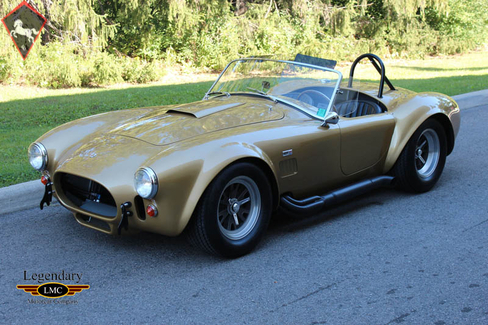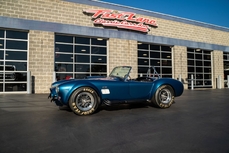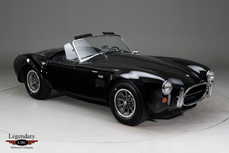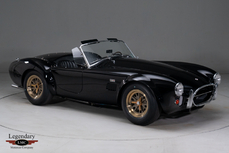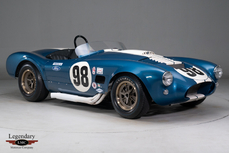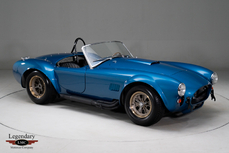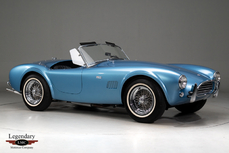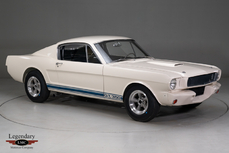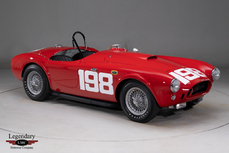Shelby Cobra 427 1965
Allgemeine Beschreibung :
3,880 original miles
A full dossier of original documents
Original owner until 2010
Original 427 side oiler dual quad engine
Original transmission and rear end
Original body and frame
Original rims and tires from this car (impossible to find or obtain)
Original seats, soft top, tools and manual
Very likely the best Semi Comp Cobra in the world
This car in the mid 1960’s, a young man by the name of William Turner was thinking about buying a new car. During the preceding years, Mr. Turner, from Fort Myers, Florida, had been successfully drag racing Pontiacs and was a master engine builder. Although his lightweight GTOs were among the most exciting cars available, he had a yearning for something a little more dramatic; he wanted to go road racing.
While in California, Mr. Turner stopped by the Shelby-American workshops in Los Angeles. At the time he wanted a 289 Competition Car, but none were available. He made some contacts at Shelby and followed up time to time in hopes that the right car would finally become available. Eventually, he was offered a recommissioned 289 race car and later, a standard 427, but neither satisfied his yearning. Finally in 1967, rather then continuing to deal with Shelby directly, Mr. Turner contacted his local Ford dealership, J.D. Ball Ford of Miami, Florida to keep him appraised of any interesting Cobras. He asked them to pursue a suitable car for him and, in due course, they called back with a lead on a 427 S/C, one of only 29 such cars. Mr. Turner knew that the S/C was, for all intents and purposes, a full competition 427 Cobra made street legal – exactly the kind of car he was looking for.
The S/C was located at Dick Walters Ford Inc. in Des Moines, lowa, and rumor had it the car just finished a stint travelling with Shelby-American’s Cobra Caravan. CSX 3021 was one of only two Cobras ever finished in Hertz Gold and, although the car was completed in March 1965, Shelby had found no takers for its most devastating performance car. In August 1966, the dramatic Cobra was ordered by Dick Walters Ford; however, by spring 1967, the 427 S/C seemed to become a permanent fixture on the showroom floor. A deal was soon struck between J.D. Ball Ford, Dick Walters Ford and Bill Turner, whereby Mr. Turner would trade in his 1966 Pontiac GTO Factory Lightweight as a partial exchange for the Cobra. The S/C cost $9,500; the Pontiac was given a $2,200 trade-in value and the difference was paid out over 48 months in $145 installments. He arrived in Des Moines in the evening and once his paperwork had cleared, Mr. Turner was ready to take delivery of his brand-new Hertz Gold 1965 Shelby 427 S/C at the time, the fastest road-going automobile ever built.
The car was equipped with a medium-riser 427, dual Holley four barrels, minimal mufflers within the side pipes, rubber suspension bushings, competition fuel tank, wide front flares and rear flares with a pronounced lip. Despite his interest in the Shelby Roadsters, Mr. Turner had never actually sat in a Cobra, let alone driven one. His acclimation to the S/C was immediate; he simply jumped in the car, asked “Which road do I hit as far as heading south?” and took off. After the chill of the lowa evening set in, Mr. Turner began to erect the top, only to discover that it was designed for a car without a roll bar and was incapable of closing properly. To solve the problem, he whipped out his pocket knife and cut a hole, allowing the roll bar to slide through the top and the cover to be safely secured.
A while later during the drive to Florida, Mr. Turner encountered a 1967 Corvette on the road. For some time, the Corvette and the Cobra dueled through the winding mountain roads. Mr. Turner reports that, during the impromptu contest, speeds of 150-160 mph were reached. Both drivers were quite impressed by the performance of each other’s cars and stopped for coffee and had a chat. It became evident that the Corvette was one of the rare L88 models and, therefor, it was no wonder the sports car was able to keep up with a street-legal competition Cobra.
When Mr. Turner returned to Florida, he was still obligated to do some drag racing. Between that and other commitments, the Cobra was never raced as was originally intended and, in 1969, it went into storage with a mere 3,000 miles on the odometer. The car remained static for many years with only the occasional drive to maintain it in running order. At some point in the late 1970s or early 1980s, Mr. Turner painted the car red. However, he returned the Cobra to its original Hertz Gold. Other than this temporary colour change, it is believed the car has been left unaltered from the moment it left the Shelby workshop in 1965.
For the past 30 years, the S/C Cobra has been shown infrequently, driven sparingly and remains essentially as delivered. On one of its rare public showings, the car was displayed at the SAAC-15 meet in Dearborn, Michigan, where it won a second place trophy; it most likely would have won first place if its long years in storage not drained the battery, thus rendering the car unmovable and unable to start for the judges. The AC-fitted Lucas headlamps are present, the Halibrand wheels still wear the original Goodyear Blue Dot and Blue Streak tires, and the engine bay offers a textbook presentation of the famous 427 V8 engine. The Cobra’s interior reflects an even more astounding level of preservation. The remains of the factory sticker are still affixed to the 180 mph counter-winding speedometer, the upholstery has an irreplaceable texture and the original top, still with its late-night modification, is carefully stowed in the trunk. From the Lucas wiring wrapped in the original electric tape to the numbered spark plug wires, this S/C Cobra proudly bears its history for all to witness and possesses a charm and integrity that can be found in a car that’s never been comprehensively restored. Above all, the odometer reads just under 3,900 miles, making it quite possibly the lowest-mileage Cobra in existence.
This irreplaceable Shelby is offered with an impressive file of original documents, as lovingly comprehensive a file as one could hope for alongside a one-owner 427 S/C. Included with the sale of this car are the original side curtains and top, the tool roll, the Cobra 247 chassis instruction book, the original invoice from J.D. Ball Ford, old vehicle registrations, the payment book used to pay the 48 installments, the original 1967 Florida title and letter from Shelby-American addressed to the Cobra’s one and only owner Mr. William Turner.
This marvelous 427 S/C Cobra is undeniably the finest of its kind and arguably the most original Shelby Cobra in existence. For the collector who appreciates one-of-a-kind cars and fascinating stories, this is the best Cobra money can buy.
*Private Collection*
http://www.legendarymotorcar.com/inventory/1965-shelby-427-cobra-sc-1436.aspx
1965 Shelby Cobra 427 is listed verkauft on ClassicDigest in Halton Hills by Legendary Motorcar for Preis nicht verfügbar.
Fakten der Auto
Karosserietyp : Auto Marke : Shelby Modell : Cobra 427 Hubraum : 0.0 Modelljahr : 1965 Lage : Halton Hills
Verkauft
Angaben Zum Verkäufer
Verkauft
People who viewed this Shelby Cobra 427 also viewed similar Shelby listed at ClassicDigest
Other cars listed for sale by this dealer
über Shelby
Carroll Shelby, eine legendäre Figur in der Automobilwelt, hatte einen bemerkenswerten Weg vom erfolgreichen Rennfahrer zum renommierten Sportwagenhersteller in den Vereinigten Staaten. Seine Geschichte ist voller Erfolge, Innovationen und ikonischer Autos, die einen unauslöschlichen Eindruck in der Branche hinterlassen haben.Frühe Jahre und Rennkarriere:
Carroll Shelby wurde 1923 in Texas geboren. Während des Zweiten Weltkriegs verfolgte er zunächst eine Karriere als Pilot, entdeckte aber nach dem Krieg seine wahre Leidenschaft im Rennsport. Shelby wurde in den 1950er Jahren ein erfolgreicher Rennfahrer und nahm an verschiedenen Veranstaltungen teil, darunter der Formel 1, Langstreckenrennen und den berühmten 24 Stunden von Le Mans.
Shelby Cobras – ikonische Sportwagen:
Carroll Shelbys entscheidender Moment als Hersteller kam mit der Entwicklung des Shelby Cobra, einem legendären amerikanischen Sportwagen. Die Cobra entstand aus der Fusion eines britischen AC-Ace-Chassis und eines Ford-V8-Motors und schuf ein leichtes Hochleistungsauto, das sowohl auf der Rennstrecke als auch auf der Straße dominierte. Zu den wichtigsten Modellen gehören:
Shelby Cobra 260 (1962): Die erste Version mit einem 260 Kubikzoll (4,2 l) V8-Motor.
Shelby Cobra 289 (1963–1965): Spätere Versionen mit einem 289-Kubikzoll-V8-Motor (4,7 l), einschließlich der Cobras mit Wettbewerbsspezifikation, die für ihre Rennfähigkeiten bekannt sind.
Shelby Cobra 427 (1965–1967): Die stärkste Version mit einem 427 Kubikzoll (7,0 l) V8-Motor, bekannt für seine rohe Kraft und Leistung.
Ford-Partnerschaft – Shelby Mustangs:
Shelbys Partnerschaft mit Ford führte zur Entwicklung der legendären Shelby Mustangs. Das bemerkenswerteste Modell ist:
Shelby GT350 (1965–1969): Basierend auf dem Ford Mustang wurde der GT350 von Shelby American modifiziert und zeichnete sich durch verbesserte Leistung, Handling und unverwechselbares Design aus.
Weitere bemerkenswerte Modelle und Erfolge:
Neben den Cobras und Mustangs leistete Shelby noch weitere bedeutende Beiträge:
Shelby Daytona Coupé: Dieses Auto wurde für den Sieg gegen Ferrari im internationalen GT-Rennsport entwickelt und war 1965 das erste amerikanische Auto, das die FIA GT-Weltmeisterschaft gewann.
Shelby Series 1: Ende der 1990er Jahre eingeführt, war dies Shelbys moderne Interpretation eines Hochleistungssportwagens.
Der Ford GT40 spielt in Carroll Shelbys Erzählung eine zentrale Rolle, insbesondere in Bezug auf seine Verbindung zu Ford und seinen bedeutenden Beitrag zum Erfolg des Autos.
Die Entwicklung des Ford GT40:
Fords Herausforderung:
Anfang der 1960er Jahre versuchte Henry Ford II, Ferrari zu erwerben, doch die Verhandlungen scheiterten. Dies bestärkte Ford in seiner Entschlossenheit, Ferrari beim prestigeträchtigen Langstreckenrennen 24 Stunden von Le Mans zu schlagen, das Ferrari mehrere Jahre lang dominiert hatte.
Zusammenarbeit mit Shelby:
Ford wandte sich an Carroll Shelby und schätzte dessen Rennsportkompetenz und Erfolgsbilanz. Shelby wurde damit beauftragt, das GT40-Projekt zu leiten und daraus einen konkurrenzfähigen Rennwagen zu machen, der Ferraris Vormachtstellung herausfordern konnte.
Entwicklung und Triumph:
Unter Shelbys Anleitung wurde der Ford GT40 einer gründlichen Entwicklung unterzogen, um anfängliche Designfehler und Leistungsprobleme zu beheben. Es wurden mehrere Iterationen erstellt:
Frühe Versuche: Die ersten Versionen des GT40 hatten Probleme mit der Zuverlässigkeit und dem Handling, was 1964 zu enttäuschenden Ergebnissen in Le Mans führte.
GT40 Mark II: Shelbys Team hat entscheidende Verbesserungen vorgenommen. Der Mark II, ausgestattet mit einem leistungsstarken V8-Motor, verbesserter Aerodynamik und verfeinerter Technik, wurde äußerst konkurrenzfähig.
Le-Mans-Sieg:
1966 errang der Ford GT40 Mark II einen historischen Sieg bei den 24 Stunden von Le Mans, wobei der von Shelby trainierte Fahrer Ken Miles das Rennen anführte. Dies war der erste Sieg eines amerikanischen Herstellers in Le Mans und brach damit die Dominanz von Ferrari.
Anhaltenden Erfolg:
Der GT40 dominierte weiterhin und gewann in den folgenden drei Jahren (1966–1969) Le Mans, sicherte sich seinen Platz in der Renngeschichte und festigte Fords Ruf als Kraft im internationalen Motorsport.
Shelbys Beitrag zum GT40-Erfolg:
Obwohl Carroll Shelby nicht direkt an der Entwicklung des GT40 beteiligt war, trugen seine Erfahrung im Rennsport und seine Fähigkeit, ein Team aus talentierten Ingenieuren, Mechanikern und Fahrern zusammenzustellen und zu leiten, entscheidend zur Verbesserung der Leistung des Autos bei. Sein Einfluss trug dazu bei, technische Probleme anzugehen, das Fahrverhalten des Autos zu verfeinern und Renntaktiken zu entwickeln, was maßgeblich zum Erfolg des GT40 auf der Rennstrecke beitrug.
Vermächtnis und Auswirkungen:
Die Siege des Ford GT40 in Le Mans unter Shelbys Führung gehören nach wie vor zu den ikonischsten Errungenschaften in der Geschichte des Motorsports. Der Erfolg des Autos festigte Shelbys Ruf als Automobilvisionär und stärkte seine Partnerschaft mit Ford weiter.
Carroll Shelbys Beteiligung am GT40-Projekt stellte seine Fähigkeit unter Beweis, ein schwieriges Projekt in eine Maschine zu verwandeln, die die Meisterschaft gewann, und fügte seiner illustren Karriere in der Automobilwelt ein weiteres bemerkenswertes Kapitel hinzu.
